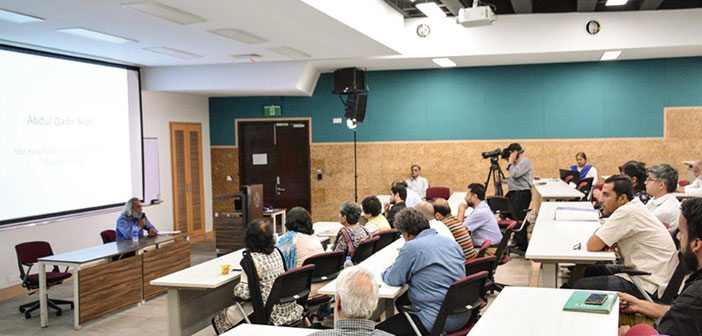Bedil’s influence on poetry in the subcontinent
Habib University’s Arzu Center for Regional Languages and Humanities took a venture into the world of Urdu poetry and prose on Wednesday, October 21, exploring the genius of Persian poet Mirza Abdul Qadir Bedil. Revered as the “Father of Meaning”, or Abul-Ma’ani, his poetry and Sabk-i-Hindi were touched upon by the illustrious Urdu poet and translator, Afzaal Ahmed Syed. The lecture was arranged as a tie-in with the University’s School of Arts, Humanities and Sciences, focusing on the love of language taught as part of Habib University’s linguistic core.
The lecture commenced with a meticulously defined profile of the poet Bedil, as told by Afzaal Ahmed Syed, progressing on to articulate the themes behind such poetry as existentialism, the human soul, of love and loss. Afzaal Ahmed Syed claimed that Bedil holds his own as one of the greatest poets to emerge from the subcontinent, and lamented the “loss of the message” that Persian poets and those of the subcontinent would spread, that of the love of God and glory, and greatness. He grieved over the fact that Persian poetry held such a stronghold in the subcontinent even as early as 150 years ago, but the beautiful language of love has eventually got lost in translation, put on a back burner rather than emerging on a throne as its rightful place.
Afzaal Ahmed Syed detailed the earlier years of Bedil, relating how the poet would lose his mother at a very young age, and travel across the Middle East and subcontinent, eventually settling in Delhi during the peak of the Mughal empire. Although originated and travelled from the regions of Afghanistan, Tajikistan, Uzbekistan and Turkmenistan, Bedil initially struggled to gain popularity in these regions. In his formative years, he was popular for his Persian verse and its integration with Hindu themes. He touched upon themes such as the insignificance and minute importance of human life as compared to the “kaina’at”, and humanity itself, shrouded in ambiguity in meticulously worded verse. Bedil was famous for dissecting the exquisite pain of human life, love and loss, but never confirming if he is, in fact, basing his poetry on humanity or a higher being.
Born in 1644, Bedil saw the emergence of Shah Jehan as one of the greatest leaders of the Mughal age, seeing the Taj Mahal built before his eyes and being part of a time in history when the Islamic revolution was at its zenith. At reaching Delhi however, it is famously said that his only possessions were a “bori” and “mitti ka pyala”. After the eventual demise of his father, Bedil was put under guardianship of his uncle who decided to home-school the illustrious poet. Bedil took to the Hindu verse and focused on improving his kalaam, quickly gaining popularity in the nearby regions. Bedil travelled to interior regions of Hindustan, jumping from city to city till he found Azam Shah’s “darbaar”. He wrote a “qaseedah” for Azam Shah, and eventually made his way back to Delhi.
Bedil saw the rise and fall of 8 Mughal empires, and was deeply touched by the Islamic history and evolution of the state. Being a devout resident of Delhi, Bedil set up his life there, eventually marrying and bearing a child, who did not survive past its 3 years. This led him to apply a Sufi lifestyle, immersing himself in the “kalaam” of various religious leaders. The Persian poet would eventually be influenced by the art of ghazals, and his style of prose would change dramatically. Due to religiously influenced backlash, many poets were made to abandon their passions in their homelands, and would make their way toward different regions of Hindustan. It was this movement that led to the fame of Hindu prose, named “Sabk-e-Hindi”.
“What set Bedil apart from the poets of his time, and those after him, was ambiguity. He left his verse unexplained, and open to interpretation and discourse”, claimed Afzaal Ahmed. This was undoubtedly true, as the poet explored the notions of love, higher being, existentialism, positivity and numerous other themes, all of which could easily be interlinked through simple terms.
Bedil’s body of work contains close to 6000 ghazals, 99,000 asha’ar and various “masnaviyaan”, his contribution to Persian and Hindu poetry is unmatched as yet, and it is a fact that poets such as Ghalib and Miir were deeply influenced by his works. “It is unacceptable, nay unforgiveable that Bedil remain forgotten in the Subcontinent, his way with words is unparalleled, especially in Persian poetry, and though many like Ghalib have tried to replicate that, none have come close”, said Afzaal Ahmed.
Bedil’s legacy is such that even Habib University’s Arzu Centre is named after one of Bedil’s most influential students. The Arzu Centre for Regional Languages and Humanities often holds such lectures on the rise of verse in Urdu language. Habib University’s School of Arts, Science and Humanities students sit engrossed in the presence of such revered personalities as Afzaal Ahmed Syed semi-regularly, allowing for the legacy of the amazing artists, scholars, influencers, poets and linguists of the subcontinent to be carried forward.











